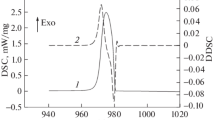Abstract
Equations for calculating the areaF below the first maximum of electron distribution curves are deduced for three models of melts as well as of amorphous solids. These models are the statistical distribution of atoms, the macroscopic segregation and the microsegregation. The latter is represented by a so-called cluster model, in which the clusters have variable diameters (up to the diameter of the first coordination sphere, i.e., about 10 Å). Furthermore, equations valid for the cluster model are given for the determination of the number of scattering electrons in the first coordination sphere of a corresponding mean atom, as well as for the determination of Cowley's short range order parameter. For the three models mentioned above the positionr I of the first maximum of the electron distribution curve can be determined. Finally the important fact is stressed that for the complete interpretation of small angle scattering experiments on amorphous solids and melts it is necessary to discuss the results of wide-angle scattering experiments.
Zusammenfassung
Beziehungen für die FlächeF unter dem ersten Maximum von Elektronenverteilungskurven werden für drei verschiedene Modelle von Schmelzen bzw. amorphen Festkörpern abgeleitet. Diese Modelle sind die statistiche Atomverteilung, die makroskopische Entmischung und die Mikroentmischung. Letztere wird durch ein sogenanntes Clustermodell repräsentiert. Dabei haben die Cluster variable Größen bis hin zur Größe der ersten Koordinationssphäre, also etwa 10 Å Durchmesser. Weiterhin werden Beziehungen angegeben zur Bestimmung der Zahl von Streuelektronen in der ersten Koordinationssphäre eines gemittelten Bezugsatoms in diesem Clustermodell und außerdem zur Bestimmung des Cowleyschen Nahordnungsparameters für dieses Modell. Für die drei oben angegebenen Modelle wird zudem noch die Beziehung zur Berechnung der Lager I des ersten Maximums der Streuelektronenverteilungskurven angegeben.
Schließlich ist noch auf die wichtige Tatsache hinzuweisen, daß zur vollständigen Interpretation von Kleinwinkelstreuxperimenten an amorphen Festkörpern und Schmelzen unbedingt auch die Ergebnisse der Weitwinkelstreuversuche herangezogen werden müssen.
Similar content being viewed by others
Literatur
Hezel, R., Steeb, S.: Z. Naturforsch.25a, 1085 (1970).
Steeb, S.: Z. Naturforsch.25a, 740 (1970).
Hezel, R.: Dissertation, Universität Stuttgart 1968.
——, Steeb, S.: Phys. kondens. Materie14, 314 (1972).
Warren, B. E., Krutter, H., Morningstar, O.: J. Amer. Ceram. Soc.19, 202 (1936).
Kaplow, R., Strong, S. L., Averbach, B. L.: In: “Local atomic arrangement studied by X-Ray diffraction”, edited by J. B. Cohen, J. E. Hilliard; Gordon and Breach, New York 1966.
Steeb, S., Dilger, H., Höhler, J.: J. Phys. Chem. Liquids1, 235 (1969).
——, Hezel, R.: Z. Phys.191, 398 (1966).
Cowley, J.: Phys. Rev.77, 669 (1950).
Steeb, S., Hezel, R.: Z. Metallkunde57, 374 (1966).
Author information
Authors and Affiliations
Rights and permissions
About this article
Cite this article
Hezel, R., Steeb, S. Mikroentmischung in binären amorphen Festkörpern und Schmelzen nach Röntgenweitwinkelbeugungsexperimenten. Phys kondens Materie 14, 307–313 (1972). https://doi.org/10.1007/BF02422687
Received:
Issue Date:
DOI: https://doi.org/10.1007/BF02422687




